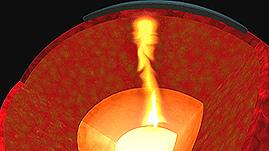Teachers' Domain - Digital Media for the Classroom and Professional Development
User: Preview


Source: Jean-Michel Cousteau: Ocean Adventures



The Hawaiian Islands are a unique island group in that they are an excellent example of land formed from a geologic process that has only recenlty been explored fully by geologists. The islands have been formed from a combination of different sub-surface volcanic activities. This visualization of the process, which comes from the Voyange to Kure episode of Jean-Michel Cousteau: Ocean Adventures, incorporates the different geoligic processes which have created the islands over thousands of years.
The vast majority of our planet’s surface is covered with water. The familiar shapes of the landmasses that we recognize today, however, did not always look the way they do now. In fact, new tracts of land are being formed in the oceans every day, while other landmasses slowly disappear. Islands that are partially submerged volcanoes, or seamounts, are created over millions of years by powerful forces below Earth's crust.
There are many types of volcanoes found on Earth. One type is known as a hotspot volcano. These are formed by stationary mantle plumes that travel up through Earth’s layers until they form an extremely hot pocket of magma just below the crust. The intense heat and pressure from the plume melt away a small hole in the crust through which magma from the mantle pushes to the surface. As the cooled magma builds up higher and higher, it creates a cone-shaped volcano. These hotspots can remain active for thousands of years. Because a hotspot stays in one place relative to the moving tectonic plates, the hotspot forms a chain of volcanoes or mountains. One example is the Hawaiian-Emperor seamount chain.Hotspot volcanoes, however, are a relatively rare method by which land is created. Most volcanoes are in fact not of the hotspot variety. Most volcanic activity is found near the point where two plates meet, known as a plate boundary. A convergent boundary occurs when one plate slides below another. In this case, the intense heat and pressure melt the lower plate, forcing magma up to the surface. This type of tectonic activity forms a line of volcanoes along the boundary. One such example is the Pacific Ring of Fire. A divergent boundary is formed when two plates are pulled away from each other. Here. magma quickly rises to the surface and cools to form new crust. The Mid-Atlantic Ridge is an example of this type of plate boundary.
 Loading Standards
Loading Standards